A stroll around Ponts
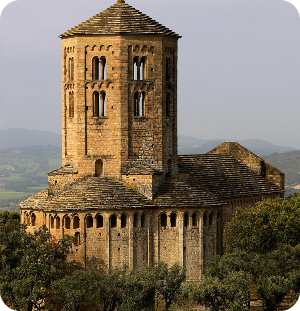
Sant Pere de Ponts
Prehistoric...
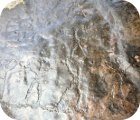
A composition of 9 male and 25 female human figures constitutes the most significant part of the engravings. These are completed with other figures such as geometrical forms, scalariform patterns and enclosed areas.
It is thought to be a religious sanctuary from between the Chalcolithic period and the early Bronze Age.
Location: outside the village of La Força
Information and visits: it is not currently open to the public.
Council of Ponts. Tel. 973 460 003.
Romanesque...
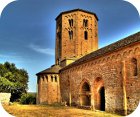 The collegiate church of Sant Pere de Ponts, 11-12th
The collegiate church of Sant Pere de Ponts, 11-12th
This was the seat of a former Augustinian monastery, which was established in the eleventh century under the patronage of the counts of Urgell. It is set on a flat area on the southern slope of the mountain of Sant Pere, the top of which is site of the ruins of the castle of Ponts. There currently remains only the church, which was constructed from donations by the counts between 1091 and 1094. It has recently been restored, largely by the Association of Friends of Sant Pere de Ponts, an institution that has undertaken successive reconstruction campaigns over a twenty-year period.
Location: by car, take a road off the C-14 (2 km), or on foot (20 minutes), follow the old, recently restored path from Ponts.
Information and visits: Free visits to the exterior. Please call Mr Manel on Tel. 638 530 123 for visits by appointment.
Ruins of castle of Ponts
Remains, in poor condition, of the castle of Ponts.
Location: on the St. Pere de Ponts site, reached by climbing a neighbouring hill crowned by some stone walls.
Information and visits: free visit.
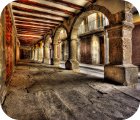 Carrer Major (Main Street) and arcades
Carrer Major (Main Street) and arcades
Inhabited by crafts and trades people who used the ground floors of the houses as workshops or shops. Independent professionals such as doctors, apothecaries, artisans and notaries also lived here.
It was the axis of the first closed compound of the old town or main settlement of Ponts, which was established in the eleventh and twelfth centuries. During the medieval period it was longitudinal in shape with two large doors at either end. This closed village was the formal result of an extremely old urban design: two rows of aligned houses around a central street running north to south. The rear outer side of the houses constituted the defensive wall.
Location: From Plaça Planell, in the town centre, to Plaça de l’Església, at one end of Ponts.
Visits: free visit.
La Torre de Dàdila, also known as Torre del Cargol, 11th
Medieval lookout tower. The original, which has a square ground plan and was built with an adobe wall, is surrounded by another circular construction, which was built with stone ashlars in the Romanesque period (11th century).
Location: on the plateau of La Força, 7 km from Ponts. It can be seen from the stretch of the C-14, which runs to Artesa de Segre.
Information and visits: visits will be possible in the near future. Council of Ponts. Tel. 973 460 003
Sta. Cecília de Torreblanca, 11th
Small cylindrical building with a simple appearance. It has a circular ground plan and a hemispherical dome, and a triple-bull’s eye window with double splay.
Location: in the middle of a field of crops, near Cobert d’Olives, some 3 km from Anya on the track to Torreblanca and some 5 km from Ponts, if travelling in the direction of Anya by Torreblanca.
Information and visits: free visit.
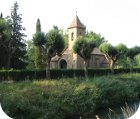 The parish church of Sant Bartomeu del Tossal, 11th
The parish church of Sant Bartomeu del Tossal, 11th
This is a very interesting building that has a nave with a barrel vault, supported by two arches supported by two arches and formers, of Romanesque origin. The head has a polygonal apse, which could have been initially devoid of a central plant building, later adapted as the apse of a church in the eleventh century.
The restoration work and agençament that have made the initiative of Fr. Sauter and Joseph Gabriel, allow us to grasp the characteristics of the pre-Romanesque structure, especially in the area of the apse.
Location: Outside the village of Tossal on the flat area between the nucleus of houses and the Segre River and near the Urgell Canal.
Information and visits: free visit.
Other periods...
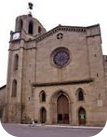 The parish church of Santa Maria de Ponts
The parish church of Santa Maria de Ponts
The ground plan features a single, large rectangular Gothic-style nave. The chancel is presided by a semicircular apse, crowned by an arch with pointed archivolts by way of late Romanesque style (13th century), and a Neogothic façade with a high octagonal adjoining bell tower on the left-hand side, from the mid-nineteenth century.
The lateral wall of the epistle side features four apertures, covered with a barrel vault: 1- provides access to the Roser chapel; 2-3, contain altars devoted to Saint Joseph and to the Immaculate Virgin, respectively, and 4- communicates the central nave with the chapel of sorrows.
The lateral wall of the Gospel side has three apertures, also covered by a barrel vault: 1- provides access to the chapel of the Holy Saviour; 2- chapel of the Sacred Heart and to the stairs that lead to the nave’s upper choir; and 3- altar dedicated to Saint Lucy and Saint Anthony of Padua. At the foot of the nave are the doorways to the former baptistery and to the bell tower.
Location: western side of what is known as the Costa de les Forques, site of the former urban centre of the town of Ponts.
Information and visits: Open during mass.
 Mare de Déu del Roser altarpiece, 17th
Mare de Déu del Roser altarpiece, 17th
Large facing, subdivided into five travées, predella and base, carved in polychrome wood and dedicated to the Virgin of the Rose Bush and to the Mysteries of the Rosary. The features of the carving and of the architectural band are in classical Baroque style from the period and although there is still doubt as to the author, the fifteen Mysteries of the Rosary, carved in wood and subsequently polychromed, appear to have come from one of the famous altarpiece workshops of the city of Manresa in the seventeenth and eighteenth centuries. Both the iconographic repertoire and the case structure are similar to those of the Roser Altarpiece of the parish church of Agramunt, which was restored in 1993.
Location: in the Roser chapel, in the parish church of Santa Maria in Ponts.
Information and visits: Open at mass times.
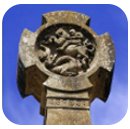 The Samarra Cross, 20th
The Samarra Cross, 20th
Privately owned preaching cross, sculpted in stone and erected at the start of the Valldans path. It marks the municipal limits of Ponts and of Oliola.
Location: at a break in the Serra del Castellà estate, which was once part of the former district known as the Town outside Ponts, which now belongs to the municipality of Oliola. It is one of the signs of identity of Valldans.
Information and visits: free visit.












